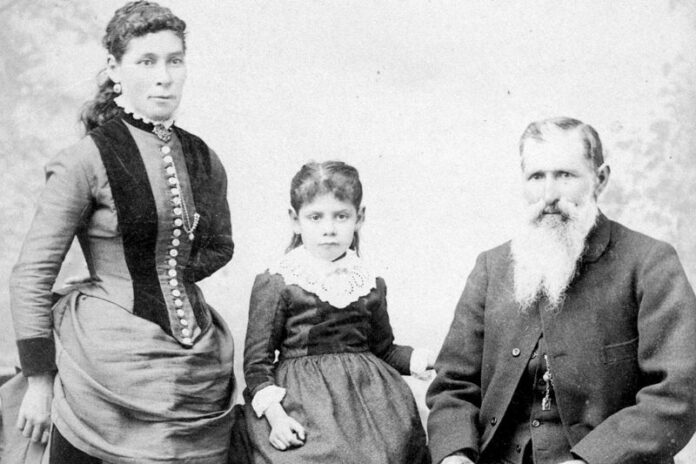
Legacy of an Italian-Spanish-Mexican-American family
The family history of former Healdsburg fire captain Don Arata gives insight into how Arata Lane received its name. Since the Aratas were early residents of the Windsor area, much is known about their history. When interviewed, Don Arata, who was born in California in 1946 and lives in Windsor, reminisced about his great-grandfather Benito Arata, who was born in Genoa, Italy, in 1831 and arrived in Sonoma County in 1884.
Benito left Italy in 1858, came to California, and settled in Milton, near Stockton, in Calaveras County. In 1868 he married Teresa Alviso, who was born in Mexico of Spanish heritage, and the couple had six children, all born in Milton. In 1884, when the children were between the ages of two and 13, the Arata family moved from Milton to Sonoma County’s Russian River Township. Benito was looking for land to farm and, hopefully, a large house with enough room for his and Teresa’s growing family.
Near the little town of Windsor, Benito found what he was looking for — 144 acres of bare land and a new house with five bedrooms. It was perfect. Don Arata said that contrary to popular belief that the historic white house now situated on Los Amigos Road was built by the Arata family, it was actually built by Windsor’s Robbins brothers, one of whom Don believes was named George.
Don recounted a comical moment about his great-grandfather Benito, who while trying to remove water that was flooding across the property, decided to “move the creek.” As a result, with his plow, he created Sotoyome Creek. Don explained that before Benito Arata’s plowing, Sotoyome Creek was only a shallow ditch that separated the Arata property from Sotoyome Rancho, not the straight course it follows today.
Don Arata not only provided information regarding his family history, but also ways in which the Arata family was unique as shown in family photographs documenting their lifestyle — scenes of work on the farm and gatherings with family and friends. Don said that his great-grandparents and grandparents often welcomed visitors and his parents also enjoyed guests while he was growing up.
The Aratas were also civic-minded. In Windsor they were active leaders in the Windsor Methodist Church, Windsor Grange, Windsor PTA, Boy Scouts, and the Windsor School Board. Don’s great-uncles also played in Healdsburg bands.
Since the Aratas were the major landowners in the area, it would seem logical that the lane on which they lived would be given their name. However, it was almost named “Hessel” by Sonoma County officials.
Don Arata had heard the story of the lane’s naming, but he referred me to Edna Brooks Honsa, who confirmed what happened.
Honsa knew both Don’s grandparents and parents, and her mother, Ethel Kerr Brooks, had been the one to suggest the name “Arata” for the lane, pointing out to the officials that there was already a county subdivision named Hessel and listing reasons why it should be named for the Aratas. Honsa is proud that her mother acted on the issue and said: “The road is well-named.”
The story of the Arata family and street name doesn’t end there. In 1948 Don’s parents, Stanley and Alta Arata, bought 320 acres at the end of Vinecrest Road. They farmed grapes, prunes, had 150 head of sheep, 4,000 chickens and a family orchard.
The property has now been subdivided and is part of Foothill Estates and Foothill Regional Park. The house that had been built in the 1870s sat where the community common area is now located. And since Arata Lane has been extended to meet Foothill Drive, the regional park now has an Arata Lane address.
Don Arata, who still lives in Windsor on land originally farmed by his great-grandfather Benito, delights in the community. “What a great place to grow up! As I walk my dog, I think about how lucky I am to have been walking on this land for 69 years!”
Kylee Faloni, a senior at Windsor High School, is currently working with Barbara Ray, the Windsor Museum and Historical Society and the Windsor Times to fulfill requirements for her senior project. With a primary interest in writing, Kylee is researching and writing about Windsor history.







